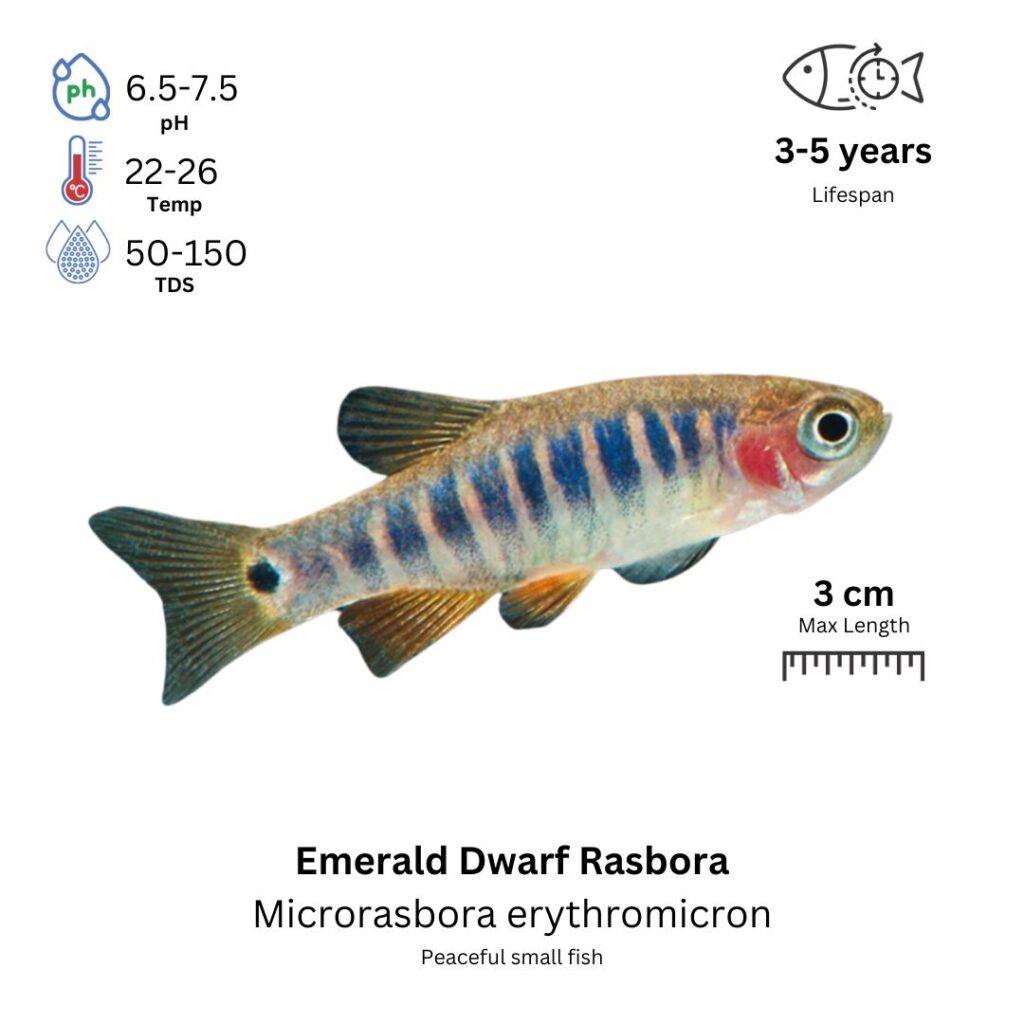Emerald Dwarf Rasbora
Boraras viridimaculatus

Description
The Emerald Dwarf Rasbora is a small and vibrant species of fish known for its striking emerald green coloration. These fish have a sleek, elongated body, and their shimmering green scales give them an almost metallic appearance. Males tend to display more intense green coloration compared to females, particularly during breeding periods. A faint red-orange stripe often runs along their bodies, which adds to their beauty. Despite their small size, Emerald Dwarf Rasboras are very active and peaceful fish that do well in schools. They are often seen swimming in the middle to upper levels of the tank, and their small size and peaceful nature make them a popular choice for planted aquariums or community tanks.
Habitat Origin
Native to Southeast Asia, particularly in Malaysia, Thailand, and Indonesia. These fish are found in slow-moving waters, such as streams and small rivers, often in heavily vegetated areas with clear, slightly acidic water. They thrive in environments with soft water and moderate flow, where they can forage among the plants and organic debris.
Aquarium
Ideal Number in Aquarium: At least 6 individuals, as they are schooling fish and feel more secure in groups.
Favorite Food

Emerald Dwarf Rasboras are omnivores and will accept a variety of foods. They can be fed high-quality flake food, micro pellets, and live or frozen foods like brine shrimp, daphnia, and bloodworms. They will also graze on small algae and biofilm in the tank, making them beneficial for maintaining a clean environment. A varied diet ensures they remain healthy and vibrant.
Behavior:
Emerald Dwarf Rasboras are peaceful and social fish that thrive in schools. They are very active swimmers and are often seen darting through the middle and upper regions of the tank. These fish do best when kept in groups of at least 6, where they can feel secure and display their natural social behavior. They are not aggressive and are ideal for peaceful community tanks with other small, non-aggressive species. However, they may become shy or stressed if kept alone or in small numbers, so it’s important to keep them in schools to exhibit their best behavior and coloration.
Special Care:
Emerald Dwarf Rasboras require stable water conditions with slightly acidic to neutral pH levels. They thrive in soft water, so regular water changes and good filtration are essential to maintain water quality. Providing a well-planted tank with plenty of hiding spots is beneficial for their well-being, as they are somewhat shy and prefer environments where they can retreat to safety. A fine gravel or sandy substrate is ideal, and the water flow should be gentle, as they are accustomed to slow-moving streams in the wild.
Compatibility with Other Fish:
Yes, Emerald Dwarf Rasboras are ideal for peaceful community tanks with other small, non-aggressive fish. They can be housed with other rasboras, small tetras, shrimp, and peaceful catfish. It’s best to avoid keeping them with large or aggressive fish, as they may become stressed or be preyed upon. Their small size and schooling nature make them ideal for aquariums focused on small, peaceful species.
Breeding Setup
It is highly recommended to use a separate breeding tank for Emerald Dwarf Rasboras to maintain precise water conditions and prevent egg or fry predation. A 20-liter (5-gallon) tank is sufficient and easy to manage. Maintain water parameters at a pH of 5.5–7.0, temperature 24–28°C, and hardness 2–8 dGH. Use a gentle sponge filter to ensure clean water without creating strong currents. Include fine substrate or bare-bottom, along with plants like Java moss, Hornwort, and floating plants such as duckweed for egg-laying and fry shelter. Soft, moderate lighting helps simulate their natural low-light environment.
Conditioning for Breeding
Conditioning Emerald Dwarf Rasboras involves offering a varied, protein-rich diet, including high-quality flakes, live brine shrimp, daphnia, microworms, and frozen bloodworms. These foods promote the development of healthy, fertile eggs. Weekly water changes of around 25% help maintain high water quality and reduce stress, creating a more favorable environment for breeding.
Spawning Process
Spawning generally takes place in the early morning or evening. Males display vivid coloration and court females by chasing and nudging them. Females scatter 50–100 adhesive eggs onto plants, glass, or substrate. After spawning, it is essential to remove the adult fish to avoid egg predation, as Emerald Dwarf Rasboras tend to eat their own eggs if left unsupervised.
Fry Care
Eggs hatch within 24–36 hours, depending on temperature. The fry initially survive on their yolk sacs before becoming free-swimming. Begin feeding them infusoria or liquid fry food, then transition to baby brine shrimp or other microscopic foods like rotifers. Perform daily 10–15% water changes to maintain excellent water quality, and keep temperature stable between 24–28°C. Carefully monitor ammonia and nitrite levels, as fry are sensitive to toxins.
Important Notes
Emerald Dwarf Rasboras reach breeding maturity at around 6 months. Males are smaller and more colorful, while females are rounder, particularly when gravid. To avoid stress-related breeding failures, maintain stable water parameters, avoid overcrowding, and provide a calm, species-only environment free of aggressive tankmates. Consistency and peace are key to successful reproduction.
